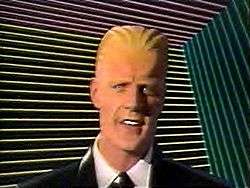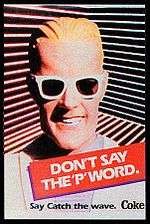Max Headroom (character)
| Max Headroom | |
|---|---|
| Max Headroom character | |
 | |
| First appearance | The Max Headroom Show |
| Last appearance | Pixels |
| Created by |
George Stone Annabel Jankel Rocky Morton |
| Portrayed by | Matt Frewer |
| Voiced by | Matt Frewer |
| Information | |
| Gender | Male |
| Occupation | Artificial intelligence |
Max Headroom is a fictional British artificial intelligence (AI) character, known for his wit and stuttering, distorted, electronically sampled voice. He was introduced in early 1984. The character was created by George Stone,[1] Annabel Jankel and Rocky Morton in the mid-1980s, and portrayed by Matt Frewer as "The World's first computer-generated TV host," although the computer-generated appearance was achieved with prosthetic makeup and hand-drawn backgrounds, as the computer technology of the time was not sufficiently advanced to achieve the desired effect. Preparing the look for filming involved a four-and-a-half-hour session in make-up, which Frewer described as "grueling" and "not fun," likening it to "being on the inside of a giant tennis ball."[2]
Creation
The classic look for the character was a shiny dark suit—which was actually a fibreglass mould—often paired with Ray-Ban Wayfarer sunglasses. Only his head and shoulders were depicted, usually against a "computer-generated" backdrop of a slowly rotating wire-frame cube interior, which was also initially generated by analogue means—in this case traditional cel animation, though later actual computer graphics were employed for the backdrop. Another distinguishing trademark of Max was his chaotic speech patterns—his voice would pitch up or down seemingly at random, or occasionally get stuck in a loop. These modulations, achieved with a harmonizer, also appeared when the character was performed live.
The character's personality was partly intended as a satire of insincere and egotistical television personalities—what Rocky Morton described as the "very sterile, arrogant, Western personification of the middle-class, male TV host," but also was "media-wise and gleefully disrespectful" which appealed to young viewers.
Matt Frewer was chosen for his ability to improvise, and his—according to producer Peter Wagg—"ideally exportable" Mid-Atlantic accent. The actor decided to model Max's personality after what he saw as the smarmy, self-important goofiness of The Mary Tyler Moore Show's Ted Baxter. In a 1986 interview, Frewer said: "I particularly wanted to get that phony bonhomie of Baxter ... Max always assumes a decade long friendship on the first meeting. At first sight he'll ask about that blackhead on your nose."
The background story provided for the Max Headroom character in his original appearance comes from a dystopian near-future dominated by television and large corporations. The AI of Max Headroom was shown to have been created from the memories of crusading journalist Edison Carter. The character's name came from the last thing Carter saw during a vehicular accident that put him into a coma—a warning sign marked "MAX. HEADROOM: 2.3 M" (i.e., a clearance of 2.3 metres) suspended across a car park entrance.
TV history
Movie
Max Headroom originally appeared in the British-made cyberpunk TV movie Max Headroom: 20 Minutes into The Future which was broadcast in 1985.
The original movie was rebroadcast on More4 on 21 October 2007 as part of the 25th birthday celebrations of Channel 4.
Max Headroom appears in Pixels by Galaga.
Max Headroom type characters appear in Back to the Future Part II in the Café 80's scene
Show
After its success, the character was spun off into a veejay in the British music video program, The Max Headroom Show, whose first episodes unusually featured no introductory title sequence or end credits. The spin-off show was an immediate cult hit, doubling Channel 4's viewing figures for its slot.
A second season, which broadened the original concept to include celebrity interviews and a studio audience, was produced in late 1985, and a third and final season ran in 1986 (The second and third seasons were shown first on the US cable channel Cinemax, and on Channel Four an average of six months later).
A Christmas special was produced at the end of the second season and seen by UK audiences just before the regular run of the season, and just after the US season concluded.
Cinemax produced a fourth season of the talk show on its own, The Original Talking Max Headroom Show, which ran for six episodes in 1987. These episodes were never shown in the UK.
Series
The final spin-off from the original film was the dramatic television series, Max Headroom, which was broadcast in the United States, running for two short seasons (Spring 1987 and Fall 1987), with two more episodes shown later in 1988.
Shout! Factory released Max Headroom: The Complete Series on DVD in the United States and Canada on August 10, 2010.
Other appearances

Max became a celebrity outside the television series. He was the spokesman for New Coke (after the return of Coca-Cola Classic), delivering the slogan "Catch the wave!" (in his trademark staccato, stuttering playback as "C-c-catch the wave!"). In the UK, Max appeared in television commercials for Radio Rentals. He also hosted an interview show on the Cinemax cable channel, called The Original Max Talking Headroom Show.
In 1987, Frewer appeared as Max Headroom in a segment for Sesame Street. He recites the alphabet with selected commentary on some of the letters.[3]
On November 22, 1987, an unidentified hijacker used Max as a basis for a hijack in the Max Headroom broadcast signal intrusion.
An older-looking Max was used in a campaign to inform UK households of the impending digital TV switchover.[4] As he is looked after by a caretaker, he moans about being with the other "relics", and then talks about digital TV. He stated that Channel 4 is now suddenly "20 years into the future", making a subtle reference to 20 Minutes into the Future.
Max makes a cameo appearance in the 2015 movie Pixels.
Musical performance
Art of Noise featured an overdubbed Max on the song "Paranoimia".[5] Max was also featured on a single titled "Merry Christmas Santa Claus (You're a Lovely Guy)" released by Chrysalis Records.[6]
The rapper Eminem performs as Max Headroom in the music video for his song "Rap God".
Although uncredited in the liner notes, Max can clearly be heard talking about various species of fish during the introductory section of the song "Home" on the Roger Waters album Radio K.A.O.S. .
Video game
In 1986, Quicksilva released a Max Headroom game, which was sold in the UK for the Sinclair ZX Spectrum and Commodore 64. The game's plot was to protect Edison Carter from criminals armed with guns, whilst rescuing Max.
The NewTek "Demo Reel One" featured a Max Headroom grab. Newtek, Inc. is a company that developed Commodore Amiga hardware and software, including a digital video sampler.
Production notes
Notwithstanding the publicity for the character, the real image of Max was not computer-generated. Computing technology in the mid-1980s was not sufficiently advanced for a full-motion, voice-synchronized human head to be practical for a television series. Max's image was actually that of actor Matt Frewer in latex and foam prosthetic makeup with a fiberglass suit created by Peter Litten and John Humphreys of Coast to Coast Productions in the UK. This was then superimposed over a moving geometric background. Even the background was not created using computer graphics at first; it was a piece of hand-drawn cel animation produced by Rod Lord, who created similar "computer-generated" images for the TV series Hitchhiker's Guide to the Galaxy. Later, in the United States version, the backgrounds were generated by a Commodore Amiga computer.
The series pilot won the British Academy of Film and Television Arts (BAFTA) award for graphics.[7]
The rights to the Max Headroom character were held by All3Media, as of November 2007.[4]
Signal intrusion event
On November 22, 1987, two Chicago television stations had their broadcast signals hijacked by an unknown person wearing a Max Headroom mask and sunglasses. The first incident took place for 25 seconds during the sportscast on the 9 O'Clock news on WGN-TV Channel 9 and two hours later around 11 o'clock on PBS affiliate WTTW Channel 11 for about 90 seconds during a broadcast of the Doctor Who episode "Horror of Fang Rock". The hacker rambled on making reference to Headroom's endorsement of Coke, the series Clutch Cargo, and WGN anchor Chuck Swirsky, then pretended to defecate as a "masterpiece for all the greatest world newspaper nerds", a reference to WGN's call letters ("World's Greatest Newspaper"). A homemade Max Headroom background rocked back and forth as he rambled, and the video ended with a pair of exposed buttocks being spanked with a flyswatter before normal programming resumed. The culprits were never caught nor identified.
Proposed film
In late 1987, following the cancellation of the American TV series, it was announced that a feature film titled Max Headroom for President would be produced. Frewer, quoted in a Marilyn Beck column in December 1987, indicated the plan was for the film, which at that point had no finalized script, to be shot in early 1988 in order to capitalize on the 1988 United States presidential election.[8] The film was never made, possibly due to the 1988 Writers Guild of America strike which erupted three months later.
References
- ↑ YouTube video at the ICA with Stone, Morton and Jankel
- ↑ "Max Headroom's Matt Frewer Interview", G4tv.com, retrieved March 3, 2010
- ↑ Max Headroom on Muppet Wiki.
- 1 2 Mark Sweney (2007-11-29). "Channel 4 resurrects Max Headroom to promote digital channels | Media". theguardian.com. Retrieved 2013-11-29.
- ↑ 1500videos.com
- ↑ Francis Volpe. "Novelty Nook, The Eighties". Mistletunes.com. Retrieved 2013-11-29.
- ↑ "Explore the Awards | BAFTA Awards". Bafta.org. Retrieved 2013-11-29.
- ↑ "Max Headroom On Way To B-b-big Screen - Chicago Tribune". Articles.chicagotribune.com. 1987-12-10. Retrieved 2013-11-29.
External links
- Interview with Matt Frewer
- Max to promote Digital TV — The Times Online
- The Max Headroom Chronicles - Comprehensive Max Headroom information site